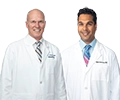
Last Updated on August 4, 2025 by Dr. Azhar I. Salahuddin
What is Strabismus?
Strabismus, also called wall eye, squint, or crossed eyes, is a condition in which the two eyes are not properly aligned and fail to work as a team when looking at an object. According to the American Association for Pediatric Ophthalmology and Strabismus, approximately 4% of the US population has strabismus.
Types of Strabismus
There are many different types of strabismus, but they can be broadly divided as follows:
Exotropia
This type of strabismus is also called wall-eyed. In Exotropia, one eye views the object directly, and the other eye turns outward away from the nose.
Esotropia
This type of strabismus is also referred to as crossed eyes or cross-eyed. In Esotropia, one eye looks at the object directly, and the other turns inward toward the nose.
Hypotropia
Hypotropia is a type of strabismus, which one eye looks directly at the object while the other turns vertically downward.
Hypertropia
Hypertropia is a type of strabismus where one eye looks directly at the object while the other turns vertically upward.
Causes of Crossed Eyes (Strabismus)
Each eye is made up of six external muscles (known as the extraocular muscles). These muscles control the eye position and its movement. In normal binocular vision, the muscles of both eyes must be coordinated perfectly.
Certain anatomical or neurological problems can interfere with the proper functioning of the extraocular muscles, thus causing strabismus. These problems can originate in the nerves or in the muscles themselves. They can also occur in the vision centers in the brain that control binocular vision.
Strabismus can also occur due to eye injuries or general health conditions.
Risk Factors of Strabismus
- Family history: People whose parents or siblings have strabismus are at risk of developing it.
- Medical conditions: People suffering from conditions such as cerebral palsy and Down syndrome, or who have had a head injury or a stroke, are more likely to develop strabismus.
- Refractive error: People who have uncorrected farsightedness or hyperopia may develop strabismus.
Signs and Symptoms of Strabismus
If you have strabismus, your eyes point outward or inward or focus in different directions. Other symptoms may include:
- Impaired vision
- Eyes that do not move together
- Decreased depth perception
- Unsymmetrical points of reflection in each eye
- Double vision
- Squinting with only one eye
- Eyestrain or headache
- Tilting the head to one side
Diagnosis of Strabismus
A doctor of optometry conducts a comprehensive eye exam to diagnose strabismus. The diagnosis may involve the following steps:
- Patient History:
The eye doctor will ask you about the symptoms. The doctor will also take note of your general health problems, medications, family history, and other environmental factors that could contribute to the symptoms.
- Eye Health Examination:
The ophthalmologist may use various testing procedures to observe the internal and external structures of your eyes to rule out any eye disease that could contribute to strabismus. The testing will help determine how the eyes respond under normal conditions.
- Visual Acuity:
The eye doctor will measure visual acuity to determine how much vision is affected. The doctor may ask you to read letters (placed near and far) on the reading charts. Visual acuity is written as a fraction. A person with normal vision has a visual acuity of 20/20.
- Refraction:
The ophthalmologist may conduct refraction to find out the lens power needed to correct any refractive error (farsightedness, nearsightedness, or astigmatism). The doctor uses an instrument called a phoropter and places a series of lenses in front of your eyes. How your eyes focus on the light is measured using a handheld lighted instrument called a retinoscope.
- Alignment and Focusing Test:
Your doctor of optometry may assess how well your eyes work together as a team to view an object. This test will help determine the problem that prevents your eyes from focusing effectively.
Your eye doctor will diagnose whether you have strabismus after evaluating the information obtained from the tests mentioned above. If you have strabismus, the ophthalmologist will discuss the treatment options with you.
Strabismus Treatment Options
There are several treatment options for crossed eyes. They include:
- Eyeglasses or Contact Lenses:
For some people, contact lenses and eyeglasses may be the only treatment needed.
- Prism Lenses:
In prism lenses, one is thicker than the other. The prisms reduce the turning of the eye to view an object by altering the light entering it. Prisms can sometimes eliminate eye turning completely.
- Vision Therapy:
Your eye doctor may prescribe a series of visual activities that can improve your eye coordination and eye focusing. These eye exercises reduce the problems with eye focusing, eye movement, and improve the eye-brain connection for effective eye teaming. These eye exercises can also be done at home.
- Eye Muscle Surgery:
The length or position of the eye muscles can be made to appear straight through eye muscle surgery. Usually, vision therapy is prescribed for patients after the surgery to prevent the eyes from becoming misaligned again and to improve eye coordination.
Also Read: Recovery After Strabismus Surgery: What to Do?
The doctors at Insight Vision Center are the most experienced ophthalmologists in California who provide the best services and treatment options for strabismus and other eye problems.
Get the eye examination done as soon as possible at our eye clinic in Fresno, CA.

Dr. Azhar I. Salahuddin is an ophthalmologist and is fellowship-trained in cornea, external diseases, and refractive surgery. Dr. Salahuddin has been performing cataract surgery for over 19 years and specializes ocular reconstruction, corneal transplantation surgery as well as vision correction through a variety of intraocular lenses. Dr. Salahuddin is board-certified by the American Board of Ophthalmology and was trained at Boston University.

